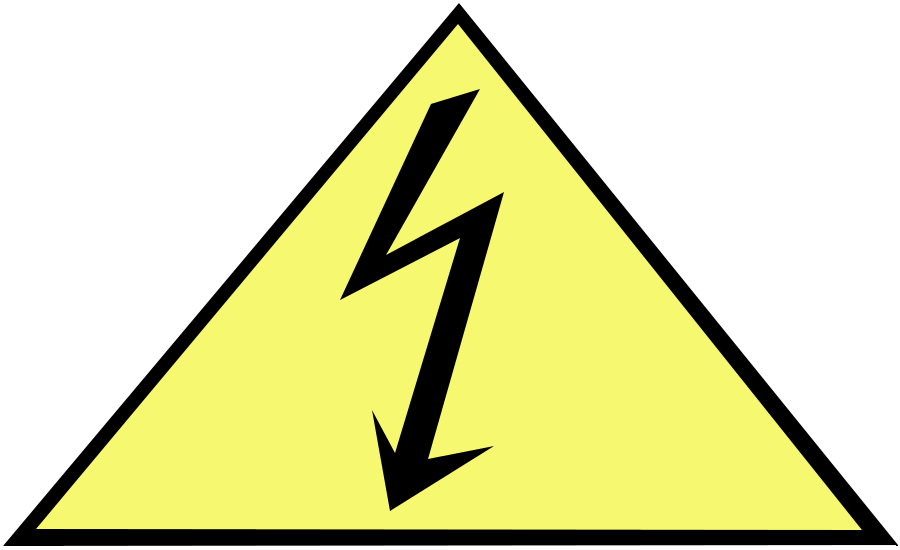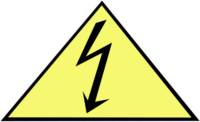Electric shock from welding and cutting equipment can result in death or severe burns. Additionally, serious injury can occur if the welder falls as a result of the shock.
All of the following are electrically energized when the power is “on”: the welding circuit (including the electrode and workpiece), input power and machine internal circuits, the wire, reel of wire, drive rolls, and all other metal parts touching the energized electrode. Additionally, incorrectly installed or improperly grounded equipment is a hazard.
Use proper precautionary measures and recommended safe practices at all times. Train all personnel using welding and cutting equipment to reduce the risk of injuries, fatalities, and electrical accidents, by following these instructions:
• Read all instructions, labels, and installation manuals before installing, operating, or servicing the equipment.
• Train all personnel involved in welding operations to observe safe electrical work practices according to OSHA
• Do not touch live electrical parts.
• Have all installation, operation, maintenance, and repair work performed only by qualified people.
• Properly install and ground the equipment in accordance with the instruction manual and national, state, and local codes.
• Frequently inspect input power cord for damage or bare wiring – replace cord immediately if damaged – bare wiring can kill.
• Do not work alone where there are electrically hazardous conditions.
• Wear dry, hole-free, insulating gloves in good condition and protective clothing.
• Do not touch the electrode with a bare hand.
• Insulate yourself from the workpiece and ground using dry insulating mats or covers big enough to prevent any physical contact with the work or ground, or wear properly designed and approved rubber-soled boots in good condition.
• Use fully insulated electrode holders. Never dip the holder into water to cool itor lay it on conductive surfaces or the work surface.
• Do not touch electrode holders connected to two welding machines at the same time since double open-circuit voltage can be present.
• Do not allow the electrode holder or electrode to come in contact with any other person or any grounded object.
• Do not use worn, damaged, undersized, or poorly spliced cables, welding gun cables, or torch cables. Make sure all connections are tight, clean, and dry.
• Do not wrap cables carrying electric current around any part of your body.
• When required by ANSI Z49.1 or other codes, ground the workpiece to a good electrical earth ground. The work lead is not a ground lead. Do not use the
work lead as a ground lead. Use a separate connection to ground the workpiece to earth.
• Do not touch an energized electrode while you are in contact with the work circuit.
When using auxiliary power from welding generators, it is recommended that you use a circuit protected by a ground fault circuit interrupter (GFCI) such as receptacles in boxes, extension cords, and the like. Use of an assured grounding system is also acceptable and is equivalent to use of a GFCI protected circuit.
Grounding of Portable and Vehicle Mounted Welding Generators, for information about assured grounding systems).
Additional safety precautions are required when welding is performed under any of the following electrically hazardous conditions: in damp locations or while wearing wet clothing; on metal floors, gratings, scaffolds, or other metal structures; in cramped positions such as sitting, kneeling, or lying; or when there is a high risk of unavoidable or accidental contact with the workpiece or ground.
Where these conditions are present, use one of the following types of equipment presented in order of preference: (1) a semiautomatic DC constant voltage metal electrode (wire) welder, (2) a DC manual covered electrode (stick) welder, or (3) an AC welder with reduced open-circuit voltage. In most situations, use of a DC, constant voltage wire welder is recommended. And, do not work alone!
Wear a safety harness to prevent falling if working above floor level.
Turn off all equipment when not in use. Disconnect the power to equipment that will be left unattended or out of service. Disconnect the input power or stop the engine before installing or servicing the equipment. Lock the input disconnect switch in the “open” (Off) position, or remove the fuses, so that power cannot be turned on accidentally. Follow lockout/tagout procedures.
Source: American Welding Society


